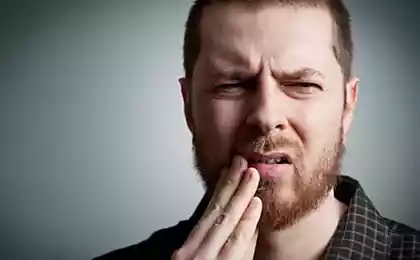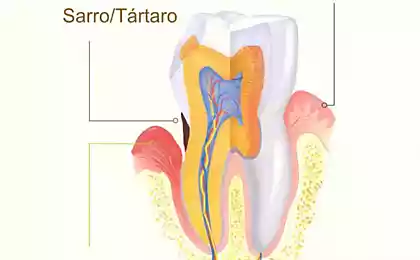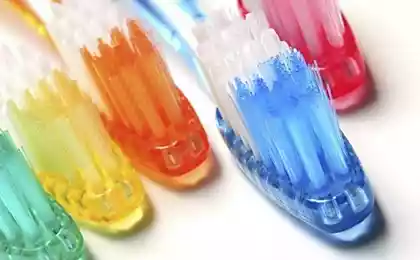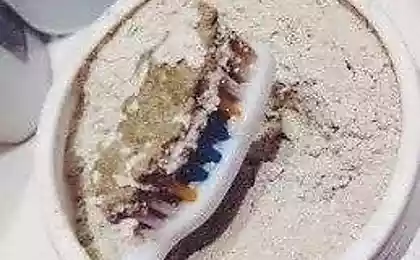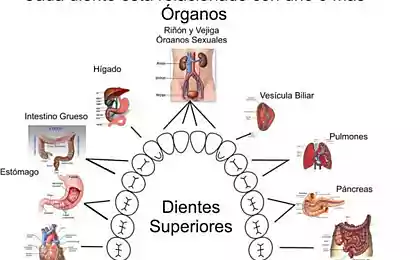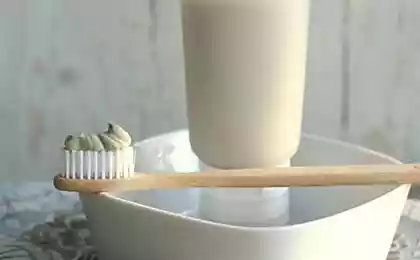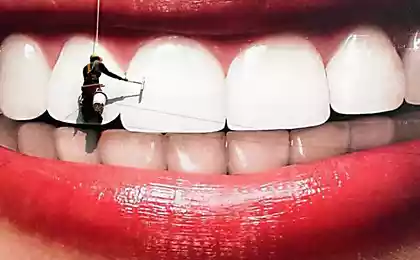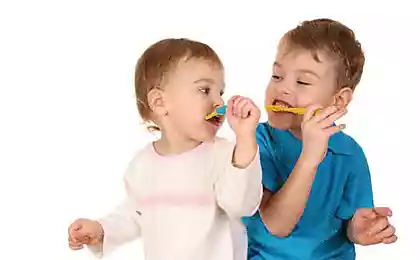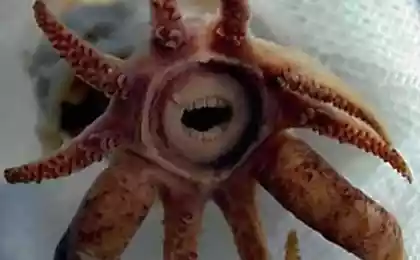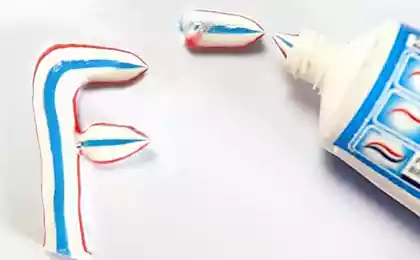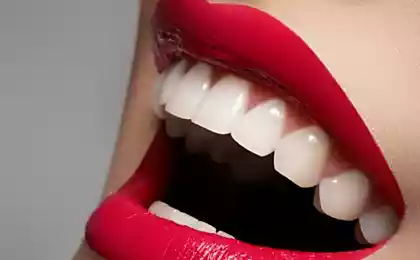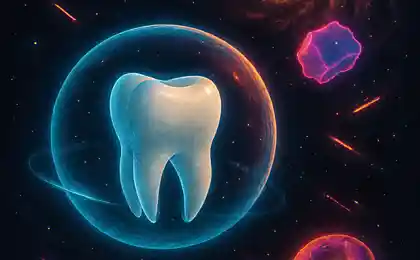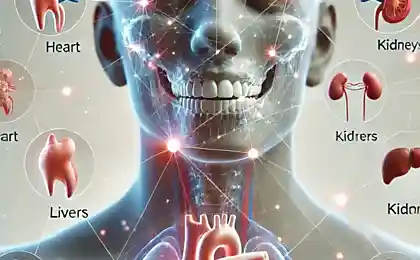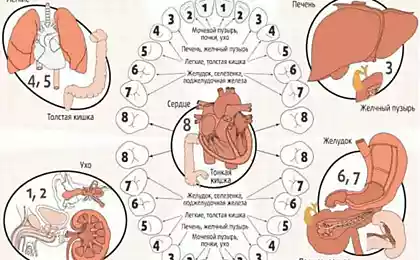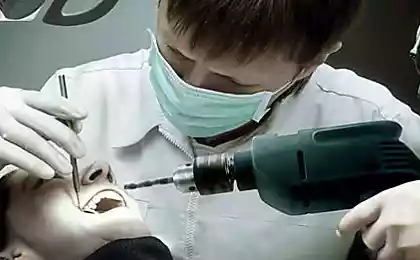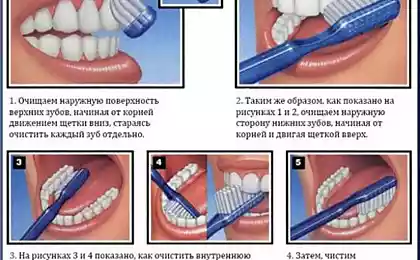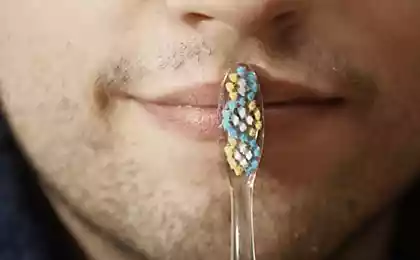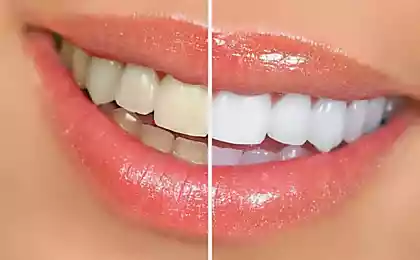914
Tooth decay can be reversed, or That You didn't know about the teeth
On the island of Sri Lanka there are an ancient temple, in the underground part of which is the stupa of gilded silver, in a Golden casket adorned with precious stones, kept the Holy relic. To see her be honored only high Buddhist officials. Only once in a year this relic comes to light and becomes the center of attention in a Grand celebration. This sacred object of worship the Tooth relic.
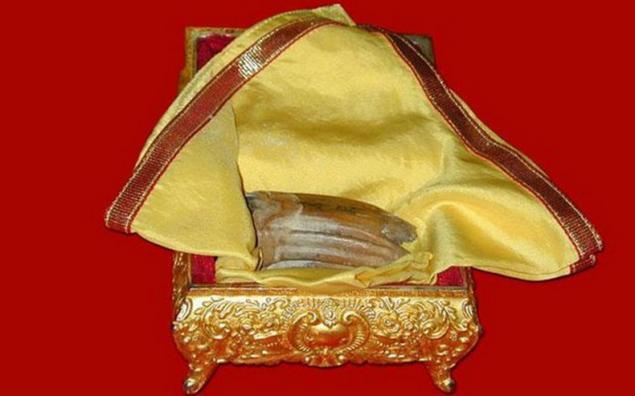
"And the inevitable end of the road"
What do we know about our teeth? Some development for them to assume, and then in the end sell? Judge for yourself: the emergence of milk teeth, replacing them with permanent root, then, depending on genetic predisposition and living conditions (water, food, disease, etc.), their more rapid or slow destruction, treatment, extraction, dentures... "Everything that is born dies."
But really there is no alternative to the fatal destruction of our teeth? Is. All living things in nature in all its splendor shows us that destruction opposes another force — the strength of the recovery, revival: "all that is born, dies and rises again...". And in the human body this force is constant: "clearly" — in skin renewal, growth of nails and hair, wound healing, bone fusion; and more secretly in periodic (from several hours to months and years) the recovery of all cells of our internal organs and tissues. And our teeth, which also are in very close relationship with the aforementioned skin and bone are not out of this universal Law. Our teeth lonely dead stones, open to all winds and exposed to their destructive onslaught, and live quite a full and protected part of a harmonious whole — the human body. What is the secret protection of our teeth?
"The armor is strong", or Hard tissues of the tooth
The first "line of defense" of the tooth is the enamel — the hardest tissue in the human body. No wonder the Greek name of the enamel (substantia adamantina, adamant) is translated as "diamond; Adamantine, irresistible, very solid, typical hardware". Underneath the enamel is the main substance of the tooth — dentin structure similar to bone, but much more solid. In the area of cervical roots and the dentin of the tooth is protected on the outside by cement is very strong, resembling bone covering. But no matter how durable the materials, the main destroyer — time — is able to inflict serious damage. If the protection will not stand a universal mechanism of life support — the recovery process — recovery. What do I need?
Well restore tooth enamel carrot, beet and cabbage juices, wheat bran.
Communication with the center, or the tooth Alive
Can itself recover the ravaged house? Only life is able to revive. Only life is able to recreate that once it's been created. And the main condition for the restoration of the communications with the centre of the renewal (the"center of life"). For tooth this nourishing and restorative center is the pulp (or "nerve"). Blood vessels and nerves in the tooth support life, provide him with the necessary materials, energy, information, clear of end-of-century elements, protect it from "intruders" and transmit needs and demands of the tooth to the "higher authorities" of the body. Pulp — the center of the tooth with the entire body (nerves and blood vessels of the pulp are connected at the tip of the root with the nervous and circulatory systems of the body). Therefore, to restore tooth structure is so important for "nerve" was alive.
What and how we feed our teeth?
To sustain life and restore damage teeth needs stable delivery of nutrients — sources of energy and building material (glucose, amino acids, enzymes, vitamins, trace elements and ions of calcium, fluorine, phosphorus, silicon). From the blood vessels of the pulp to all tissues of the tooth diverge special channels — the ways of spreading of these substances.
But, it turns out, the pulp is not the only source of nutrition of the tooth. It turns out that such a solid tissue of the tooth, as the enamel, dentin and cementum is permeable to glucose, amino acids, vitamins, calcium ions, etc., in the oral cavity, where these substances can freely pass through the entire thickness of the tooth and reach the pulp. So the tooth is able to get everything you need to power and restore directly from what we eat ourselves. From here becomes clear a advice.
For example, to chew food long and thoroughly, brush your teeth and rinse your mouth for various therapeutic and cleansing compositions for at least two minutes (and preferably, especially in the case of mouthwashes, all ten) to a tooth managed to obtain the desired substance from the "source".
The same principle (dependence of the effect of duration of exposure) is true in the case of destructive substances (especially for the already weakened teeth). What are these substances? It is primarily the acid, sugar and microbial toxins. And sugar is doubly treacherous: it not only serves as a favorite food for bacteria that produce dangerous acids, but also, once in the body, in the process of assimilation takes away from precious teeth calcium.
The example of sugar you can see how nutrition affects the condition of our teeth: (what and how long we dwell in the mouth) and indirectly through the blood. And depending on the composition and purity of the blood can either strengthen or destroy the teeth. Purity of blood — a sure sign of the health of all our organs. And our teeth (in their color, size, shape, degree of preservation), as a mirror reflects the state of the organism as a whole. No wonder in the old days about the good health of the future bride or groom was judged very simply — healthy teeth.
Toothbrush from vegetables and fruits
Blood and saliva not only nourish our teeth, and clean them from unnecessary and toxic substances. Therefore, the food you eat may be feeding, and cleaning (or, conversely, introducing in our mouth and the body extra junk). Teeth-cleaning properties have juicy fruits and vegetables (e.g. raw apples, carrots, beets and cabbage), and wheat bran. Fruits and vegetables contribute to the processes of self-cleaning of teeth as cause profuse salivation. In addition, fresh fruit contains bacteria is detrimental to the volatile substance. Twigs of fruit trees and shrubs (shoots of pear, viburnum, Rowan, currants, sea buckthorn), stems of vegetables (carrots, celery) can be used as a full toothbrush. To do this, a twig on one end need to chew and continue to use as a normal brush. After 2-3 times of application of the sprig should be replaced with fresh. These natural toothbrushes have long been used by the Indians.
Roman patricians toothbrush used a powder based on egg-shells or crushed bones, mixed with honey, rose petals, coconut and myrrh. After brushing, the mouth is rinsed with wine.
Profession — Stroitel
The presence in the blood and food required for repair of tooth substances, the established system of their delivery to the place of repair and waste collection — conditions are important, but insufficient. Needs to be a "major professionals" who know how to make life-saving repairs and are able at the right time and right place to implement your knowledge. These are special cells (odonto– blasts). These cell-builders and the nearest relative of the tooth — bone (called osteoblasts).
Because our bones are not only able to heal fractures. Throughout life bones are constantly being rebuilt: old tissue is resorbed and supplies the body with essential minerals (e.g. calcium and phosphorus), a new newly formed. And we do not notice it (unless, of course, the destruction will happen faster recovery). Such constant change is characteristic of the hard tissues of the tooth (enamel, dentin, cement). Cycle of destruction-reconstruction are visible in the decrease-increase amounts of mineral salts. And if necessary and in the restoration of broken integrity of the tooth structure.
All this is the handiwork of the cell-builders. And they live in all parts of the tooth and in the outer layer of his "center of life" — pulp. These cells and realize the connection between the pulp and other tissues. How? With their long, branching and interacting processes, which go through the entire thickness of the dentin and even go to the "territory" of the enamel. On them, as through channels, to the damaged tissue and rushes is necessary for recovery substance. Even the death of the cells is not the reason for the final destruction of the tooth because the pulp has a spare cell, which in this case acquire the qualification of "builders".
The tooth consists of a protruding into the oral cavity of the crown, the neck and immersed in the jaw bone root. The main substance of the tooth — the dentin, the crown covered with enamel, the neck and root — cement.
Enamel — transformed epithelium; 96-98% consists of minerals (phosphate, carbon dioxide and hydrogen fluoride, the calcium salt of silicon), and 2-4% organic elements (proteins type eucerotinae). The ordered structure of the enamel presented a homogeneous prisms and besprizornymi glue.
The color of the enamel. Ivory color with a matte sheen is ideal from the point of view of medicine. Too white may indicate disorders of mineral metabolism, pearl in anemia, yellow — liver problems or abuse of nicotine, brown — compromised immune system, or pathology of the intestine.
Dentin. Chemical composition identical to bone, but much harder. 2/3 consists of mineral salts (mainly phosphate and calcium carbonate) and 1/3 of the organic matter (collagen). The structure of the dentine represented the primary substance permeated by numerous thin dentinal tubules (fine tubes running radially from the pulp to the enamel and cement). In the cavity of the tubules are processes of odontoblasts (cells of the tooth).
Cement. Very similar in composition to bone tissue. 66% consists of mineral salts (mainly phosphate and calcium carbonate).
While in the discharge of miracles...
Strategy and tactics of rehabilitation works borrowed "builders" from deep childhood — the period of formation of milk, and then permanent teeth. As cells build tooth? First, they produce tooth tissue in a "soft" condition, then, in order to give it the enduring of hardness, impregnated with this frame mineral salts (mainly phosphate and calcium). And then, when a tooth is completely formed, constantly take care to maintain it in order. Sometimes they do it.
Miracle the first: tooth decay may not be. A similar phenomenon was observed by Italian dentists, visited several monasteries in Tibet. Out of 150 surveyed the monks at 70% was not a single patient's tooth, and the rest of the cavities were very limited. What is the reason? Partly in feeding habits. The traditional menu includes Tibetan monks, barley cakes, butter made from Yak milk, Tibetan tea; in the summer, added turnips, potatoes, carrots, some rice, eliminated sugar and meat.
And if caries of the teeth is already damaged?
Miracle two: tooth decay can be reversed. An example of this is observed by the dentist cases of self-healing of caries, when the affected tissue become strong again, and restored section of the tooth acquires a darker shade. And such cases are not rare. How does it happen? Cell builders show damage and restore the integrity of the tooth in the same sequence in which it was originally created. Well, if the tooth won, and from tooth to nothing? Then the prosthetics, of course. Or...
The third miracle: can grow new teeth. It is called "third shift teeth" and is observed in people of very old age. Although humans have no rudiments of teeth of the third generation, but there remains "forever young" tissues that suddenly, for reasons not fully understood remember about his mission to become teeth and successfully realize their potential. Similar posts lately are not uncommon: in 110-year-old resident of the Indian state of Uttar Pradesh has grown two new teeth; new teeth started to cut at the 94-year-old resident of Cheboksary and 104-year-old woman from Tatarstan; six teeth came from 85-year-old Novgorodka... of Course, sensations may be skeptical. If not... the latest discoveries of science.
A scientifically proven miracle. A group of scientists from the American research center in Texas, headed by Dr. McDougall studied special cells producing dental tissues (enamel and dentin). The genes responsible for this production, is active only during the formation of the tooth, and then turns off. The scientists managed these genes back on "insert" and to grow a full tooth (while "in vitro" outside the organism). However, to expect speedy changes in the practice of prosthetics is not necessary. On the dissemination of cultivation technology of their own teeth will take at least 20 years...
Throughout life there is a change of teeth most fish, amphibians and reptiles. The sharks certainly not going to stay without teeth! For the life of shark alters their thousands. The place of the broken front teeth is a new one from the next row.
Now a natural question arises: why are our teeth, endowed with such tremendous potential for recovery, still destroyed? Why with the age of the erased enamel and dentin and decreases their permeability, channel-ways become impassable (the so-called "dead road"), blood supply worsens, cells die builders, and form the remaining tooth tissue with the wrong structure and insufficient strength? Why the destruction begins to dominate over the creation? Why the harmony is disturbed?
Why do people need teeth? Not just to chew (grind food), but in order to have a correct diction. In collaboration with the language of the teeth involved in the formation of sounds T, D, S, N, R, s, C, H; with the lips in the formation of sounds In F.
"We were born to make a fairy tale come true"
The reasons for the destruction of the teeth can be a great many. And of course we can look for them and try to prevent or, what is basically happening now, to deal with the consequences. We can fight with the power of destruction. But we can also call on the assistance of another power, the power of recovery, of rebirth. And in the awakening of this force is not the last role play of our knowledge and belief that it is possible.
Pasta yogis (according to V. V. Vostokova)
Pour into a saucer a few drops of olive oil, add a pinch of sea salt, grind in a coffee grinder. Brush your teeth (and gums) can be an ordinary toothbrush, fingers, and can branch (shoots of pear, Linden, viburnum, mountain ash; the stems of carrots, celery) with a chewed end.
Tincture mouthwash (for B. Bolotov)
Preparation: 0.5 liters of vodka to mix with 0.5 cups of chopped calamus root, infuse for two weeks. 0.5 liters of vodka to mix with 10-20 grams of finely chopped propolis, infuse for two weeks. Mix 1 tbsp of tincture of calamus with 0.5–1 tsp tincture of propolis, gargle 2-3 minutes. Apply within one month. Propolis and alkaloids calamus penetrate into the tooth tissue, anesthetized and sealed microcracks. Stop the development of caries, periodontal disease and other diseases of the oral cavity. published
P. S. And remember, only by changing their consumption — together we change the world! ©
Join us in Facebook , Vkontakte, Odnoklassniki
Source: www.newacropolis.ru/magazines/3_2003/Nesokr_zub/

"And the inevitable end of the road"
What do we know about our teeth? Some development for them to assume, and then in the end sell? Judge for yourself: the emergence of milk teeth, replacing them with permanent root, then, depending on genetic predisposition and living conditions (water, food, disease, etc.), their more rapid or slow destruction, treatment, extraction, dentures... "Everything that is born dies."
But really there is no alternative to the fatal destruction of our teeth? Is. All living things in nature in all its splendor shows us that destruction opposes another force — the strength of the recovery, revival: "all that is born, dies and rises again...". And in the human body this force is constant: "clearly" — in skin renewal, growth of nails and hair, wound healing, bone fusion; and more secretly in periodic (from several hours to months and years) the recovery of all cells of our internal organs and tissues. And our teeth, which also are in very close relationship with the aforementioned skin and bone are not out of this universal Law. Our teeth lonely dead stones, open to all winds and exposed to their destructive onslaught, and live quite a full and protected part of a harmonious whole — the human body. What is the secret protection of our teeth?
"The armor is strong", or Hard tissues of the tooth
The first "line of defense" of the tooth is the enamel — the hardest tissue in the human body. No wonder the Greek name of the enamel (substantia adamantina, adamant) is translated as "diamond; Adamantine, irresistible, very solid, typical hardware". Underneath the enamel is the main substance of the tooth — dentin structure similar to bone, but much more solid. In the area of cervical roots and the dentin of the tooth is protected on the outside by cement is very strong, resembling bone covering. But no matter how durable the materials, the main destroyer — time — is able to inflict serious damage. If the protection will not stand a universal mechanism of life support — the recovery process — recovery. What do I need?
Well restore tooth enamel carrot, beet and cabbage juices, wheat bran.
Communication with the center, or the tooth Alive
Can itself recover the ravaged house? Only life is able to revive. Only life is able to recreate that once it's been created. And the main condition for the restoration of the communications with the centre of the renewal (the"center of life"). For tooth this nourishing and restorative center is the pulp (or "nerve"). Blood vessels and nerves in the tooth support life, provide him with the necessary materials, energy, information, clear of end-of-century elements, protect it from "intruders" and transmit needs and demands of the tooth to the "higher authorities" of the body. Pulp — the center of the tooth with the entire body (nerves and blood vessels of the pulp are connected at the tip of the root with the nervous and circulatory systems of the body). Therefore, to restore tooth structure is so important for "nerve" was alive.
What and how we feed our teeth?
To sustain life and restore damage teeth needs stable delivery of nutrients — sources of energy and building material (glucose, amino acids, enzymes, vitamins, trace elements and ions of calcium, fluorine, phosphorus, silicon). From the blood vessels of the pulp to all tissues of the tooth diverge special channels — the ways of spreading of these substances.
But, it turns out, the pulp is not the only source of nutrition of the tooth. It turns out that such a solid tissue of the tooth, as the enamel, dentin and cementum is permeable to glucose, amino acids, vitamins, calcium ions, etc., in the oral cavity, where these substances can freely pass through the entire thickness of the tooth and reach the pulp. So the tooth is able to get everything you need to power and restore directly from what we eat ourselves. From here becomes clear a advice.
For example, to chew food long and thoroughly, brush your teeth and rinse your mouth for various therapeutic and cleansing compositions for at least two minutes (and preferably, especially in the case of mouthwashes, all ten) to a tooth managed to obtain the desired substance from the "source".
The same principle (dependence of the effect of duration of exposure) is true in the case of destructive substances (especially for the already weakened teeth). What are these substances? It is primarily the acid, sugar and microbial toxins. And sugar is doubly treacherous: it not only serves as a favorite food for bacteria that produce dangerous acids, but also, once in the body, in the process of assimilation takes away from precious teeth calcium.
The example of sugar you can see how nutrition affects the condition of our teeth: (what and how long we dwell in the mouth) and indirectly through the blood. And depending on the composition and purity of the blood can either strengthen or destroy the teeth. Purity of blood — a sure sign of the health of all our organs. And our teeth (in their color, size, shape, degree of preservation), as a mirror reflects the state of the organism as a whole. No wonder in the old days about the good health of the future bride or groom was judged very simply — healthy teeth.
Toothbrush from vegetables and fruits
Blood and saliva not only nourish our teeth, and clean them from unnecessary and toxic substances. Therefore, the food you eat may be feeding, and cleaning (or, conversely, introducing in our mouth and the body extra junk). Teeth-cleaning properties have juicy fruits and vegetables (e.g. raw apples, carrots, beets and cabbage), and wheat bran. Fruits and vegetables contribute to the processes of self-cleaning of teeth as cause profuse salivation. In addition, fresh fruit contains bacteria is detrimental to the volatile substance. Twigs of fruit trees and shrubs (shoots of pear, viburnum, Rowan, currants, sea buckthorn), stems of vegetables (carrots, celery) can be used as a full toothbrush. To do this, a twig on one end need to chew and continue to use as a normal brush. After 2-3 times of application of the sprig should be replaced with fresh. These natural toothbrushes have long been used by the Indians.
Roman patricians toothbrush used a powder based on egg-shells or crushed bones, mixed with honey, rose petals, coconut and myrrh. After brushing, the mouth is rinsed with wine.
Profession — Stroitel
The presence in the blood and food required for repair of tooth substances, the established system of their delivery to the place of repair and waste collection — conditions are important, but insufficient. Needs to be a "major professionals" who know how to make life-saving repairs and are able at the right time and right place to implement your knowledge. These are special cells (odonto– blasts). These cell-builders and the nearest relative of the tooth — bone (called osteoblasts).
Because our bones are not only able to heal fractures. Throughout life bones are constantly being rebuilt: old tissue is resorbed and supplies the body with essential minerals (e.g. calcium and phosphorus), a new newly formed. And we do not notice it (unless, of course, the destruction will happen faster recovery). Such constant change is characteristic of the hard tissues of the tooth (enamel, dentin, cement). Cycle of destruction-reconstruction are visible in the decrease-increase amounts of mineral salts. And if necessary and in the restoration of broken integrity of the tooth structure.
All this is the handiwork of the cell-builders. And they live in all parts of the tooth and in the outer layer of his "center of life" — pulp. These cells and realize the connection between the pulp and other tissues. How? With their long, branching and interacting processes, which go through the entire thickness of the dentin and even go to the "territory" of the enamel. On them, as through channels, to the damaged tissue and rushes is necessary for recovery substance. Even the death of the cells is not the reason for the final destruction of the tooth because the pulp has a spare cell, which in this case acquire the qualification of "builders".
The tooth consists of a protruding into the oral cavity of the crown, the neck and immersed in the jaw bone root. The main substance of the tooth — the dentin, the crown covered with enamel, the neck and root — cement.
Enamel — transformed epithelium; 96-98% consists of minerals (phosphate, carbon dioxide and hydrogen fluoride, the calcium salt of silicon), and 2-4% organic elements (proteins type eucerotinae). The ordered structure of the enamel presented a homogeneous prisms and besprizornymi glue.
The color of the enamel. Ivory color with a matte sheen is ideal from the point of view of medicine. Too white may indicate disorders of mineral metabolism, pearl in anemia, yellow — liver problems or abuse of nicotine, brown — compromised immune system, or pathology of the intestine.
Dentin. Chemical composition identical to bone, but much harder. 2/3 consists of mineral salts (mainly phosphate and calcium carbonate) and 1/3 of the organic matter (collagen). The structure of the dentine represented the primary substance permeated by numerous thin dentinal tubules (fine tubes running radially from the pulp to the enamel and cement). In the cavity of the tubules are processes of odontoblasts (cells of the tooth).
Cement. Very similar in composition to bone tissue. 66% consists of mineral salts (mainly phosphate and calcium carbonate).
While in the discharge of miracles...
Strategy and tactics of rehabilitation works borrowed "builders" from deep childhood — the period of formation of milk, and then permanent teeth. As cells build tooth? First, they produce tooth tissue in a "soft" condition, then, in order to give it the enduring of hardness, impregnated with this frame mineral salts (mainly phosphate and calcium). And then, when a tooth is completely formed, constantly take care to maintain it in order. Sometimes they do it.
Miracle the first: tooth decay may not be. A similar phenomenon was observed by Italian dentists, visited several monasteries in Tibet. Out of 150 surveyed the monks at 70% was not a single patient's tooth, and the rest of the cavities were very limited. What is the reason? Partly in feeding habits. The traditional menu includes Tibetan monks, barley cakes, butter made from Yak milk, Tibetan tea; in the summer, added turnips, potatoes, carrots, some rice, eliminated sugar and meat.
And if caries of the teeth is already damaged?
Miracle two: tooth decay can be reversed. An example of this is observed by the dentist cases of self-healing of caries, when the affected tissue become strong again, and restored section of the tooth acquires a darker shade. And such cases are not rare. How does it happen? Cell builders show damage and restore the integrity of the tooth in the same sequence in which it was originally created. Well, if the tooth won, and from tooth to nothing? Then the prosthetics, of course. Or...
The third miracle: can grow new teeth. It is called "third shift teeth" and is observed in people of very old age. Although humans have no rudiments of teeth of the third generation, but there remains "forever young" tissues that suddenly, for reasons not fully understood remember about his mission to become teeth and successfully realize their potential. Similar posts lately are not uncommon: in 110-year-old resident of the Indian state of Uttar Pradesh has grown two new teeth; new teeth started to cut at the 94-year-old resident of Cheboksary and 104-year-old woman from Tatarstan; six teeth came from 85-year-old Novgorodka... of Course, sensations may be skeptical. If not... the latest discoveries of science.
A scientifically proven miracle. A group of scientists from the American research center in Texas, headed by Dr. McDougall studied special cells producing dental tissues (enamel and dentin). The genes responsible for this production, is active only during the formation of the tooth, and then turns off. The scientists managed these genes back on "insert" and to grow a full tooth (while "in vitro" outside the organism). However, to expect speedy changes in the practice of prosthetics is not necessary. On the dissemination of cultivation technology of their own teeth will take at least 20 years...
Throughout life there is a change of teeth most fish, amphibians and reptiles. The sharks certainly not going to stay without teeth! For the life of shark alters their thousands. The place of the broken front teeth is a new one from the next row.
Now a natural question arises: why are our teeth, endowed with such tremendous potential for recovery, still destroyed? Why with the age of the erased enamel and dentin and decreases their permeability, channel-ways become impassable (the so-called "dead road"), blood supply worsens, cells die builders, and form the remaining tooth tissue with the wrong structure and insufficient strength? Why the destruction begins to dominate over the creation? Why the harmony is disturbed?
Why do people need teeth? Not just to chew (grind food), but in order to have a correct diction. In collaboration with the language of the teeth involved in the formation of sounds T, D, S, N, R, s, C, H; with the lips in the formation of sounds In F.
"We were born to make a fairy tale come true"
The reasons for the destruction of the teeth can be a great many. And of course we can look for them and try to prevent or, what is basically happening now, to deal with the consequences. We can fight with the power of destruction. But we can also call on the assistance of another power, the power of recovery, of rebirth. And in the awakening of this force is not the last role play of our knowledge and belief that it is possible.
Pasta yogis (according to V. V. Vostokova)
Pour into a saucer a few drops of olive oil, add a pinch of sea salt, grind in a coffee grinder. Brush your teeth (and gums) can be an ordinary toothbrush, fingers, and can branch (shoots of pear, Linden, viburnum, mountain ash; the stems of carrots, celery) with a chewed end.
Tincture mouthwash (for B. Bolotov)
Preparation: 0.5 liters of vodka to mix with 0.5 cups of chopped calamus root, infuse for two weeks. 0.5 liters of vodka to mix with 10-20 grams of finely chopped propolis, infuse for two weeks. Mix 1 tbsp of tincture of calamus with 0.5–1 tsp tincture of propolis, gargle 2-3 minutes. Apply within one month. Propolis and alkaloids calamus penetrate into the tooth tissue, anesthetized and sealed microcracks. Stop the development of caries, periodontal disease and other diseases of the oral cavity. published
P. S. And remember, only by changing their consumption — together we change the world! ©
Join us in Facebook , Vkontakte, Odnoklassniki
Source: www.newacropolis.ru/magazines/3_2003/Nesokr_zub/
7 reasons to have a pet
10 best quotes by Vadim Zeland about the life position of the creator of his reality


